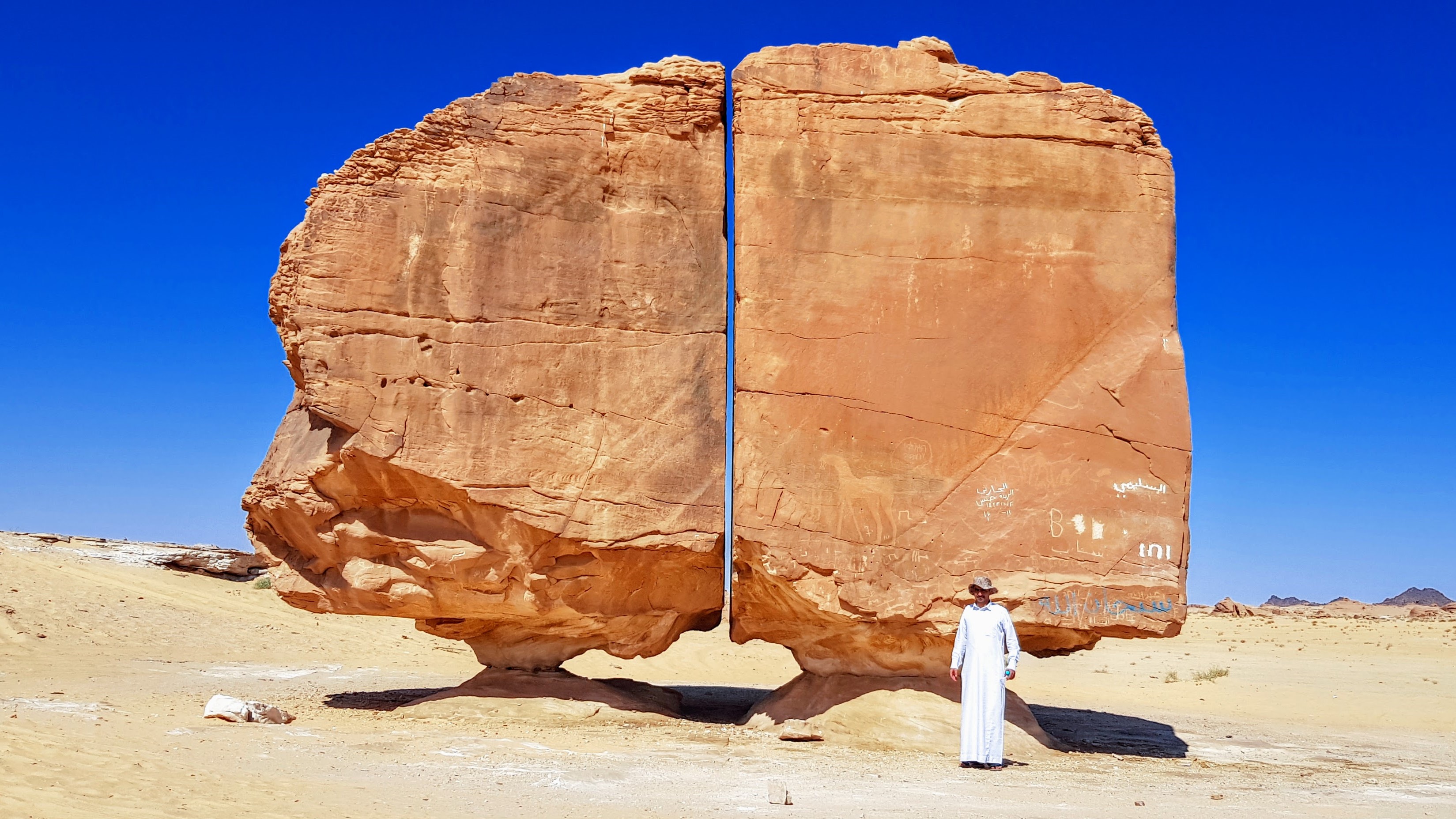Al Naslaa rock: Saudi Arabia's enigmatic sandstone block that's split perfectly down the middle
Al Naslaa is a rock formation in Saudi Arabia's northwestern desert consisting of two huge, symmetrical stone blocks that are separated by a mysterious gap and sit on small pedestals.

Name: Al Naslaa Rock Formation
Location: Tayma Oasis, Saudi Arabia
Coordinates: 27.22945094566651, 38.57172918119734
Why it's incredible: The rock formation is split cleanly down the middle as if cut by a laser.
The Al Naslaa Rock Formation is a landmark in the Saudi Arabian desert formed of two big blocks of sandstone separated by a mysterious, pencil-thin gap. The gap is almost perfectly straight and smooth, dividing what was once a massive rock into symmetrical twins.
The Al Naslaa formation is roughly 20 feet (6 meters) tall and 30 feet (9 m) wide. Scientists don't know how the strange gap between the two blocks formed, but it appears to be of natural origin, according to Geology Science, a website that covers news and trends in geology. Researchers have proposed several theories to explain the rock's middle parting, one of which suggests that the gap opened as a result of plate tectonics.
Related: Remains of hundreds of 7,000-year-old 'standing stone circles' discovered in Saudi Arabia
Al Naslaa is located in a remote and arid region of northwestern Saudi Arabia that occasionally experiences tectonic shifts, according to Geology Science. Researchers think a sudden movement of Earth's crust may have shifted and fractured Al Naslaa. The blocks are made of sandstone, meaning the stone is layered and therefore relatively fragile. But something must then have polished the fracture, as a fissure resulting from plates moving beneath the rock would be unlikely to turn out so smooth.
Researchers suggest that for thousands of years after the rock split, wind and water went to work on the two halves. The newly formed gap may have created a channel for winds carrying sand and other abrasive particles that gradually eroded both sides of the rock until they were perfectly smooth, according to Geology Science.
Another theory is that the gap formed due to a joint, which is when a rock breaks apart naturally but without being directly displaced. Joints can result from regional tectonics — including processes that compress Earth's crust to form mountain chains — or from the rock cooling, according to the Swiss Federal Institute of Technology in Zurich (ETHZ). Joints often break rocks along straight lines, but as with the previous theory, erosion may have helped smooth the fissure out.
A third theory is that Al Naslaa split in half as a result of water freezing and expanding small cracks in the rock. These small cracks may have eventually joined together and opened the straight gap we see today. In this case, Al Naslaa would have become two separate rocks as a cool period came to an end thousands or millions of years ago, melting the water in the gap.
Get the world’s most fascinating discoveries delivered straight to your inbox.
If Al Naslaa wasn't puzzling enough already, its two blocks each sit on a little pedestal, making it look like the formation is levitating. These pedestals are natural and surprisingly common in desert landscapes. Known as "mushroom rocks," blocks like this usually result from winds that blow faster close to the ground than higher up.
The Al Naslaa blocks also hold petroglyphs, which are symbols and pictures carved into the rock. Researchers have documented engravings of Arabian horses, ibexes and humans that are thousands of years old at Al Naslaa, but exactly when they were made remains a mystery.
Discover more incredible places, where we highlight the fantastic history and science behind some of the most dramatic landscapes on Earth.

Sascha is a U.K.-based staff writer at Live Science. She holds a bachelor’s degree in biology from the University of Southampton in England and a master’s degree in science communication from Imperial College London. Her work has appeared in The Guardian and the health website Zoe. Besides writing, she enjoys playing tennis, bread-making and browsing second-hand shops for hidden gems.


